Tomato Overload! Making the Most of Your Summer Harvest
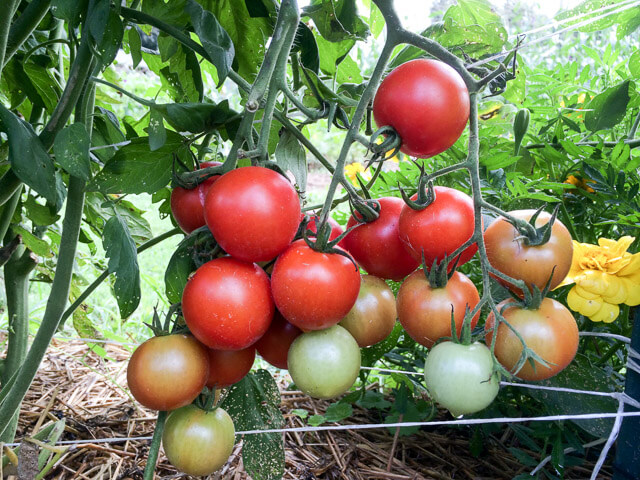 We want to make the most of our summer harvest, but Colby and I look at each other and wonder, “WHAT are we going to do with all these tomatoes?”
We want to make the most of our summer harvest, but Colby and I look at each other and wonder, “WHAT are we going to do with all these tomatoes?”
It has been a really good year for tomatoes. Some of our plants are over 9-feet tall, fruit is falling off the vines, and we are definitely feeling tomato overload.
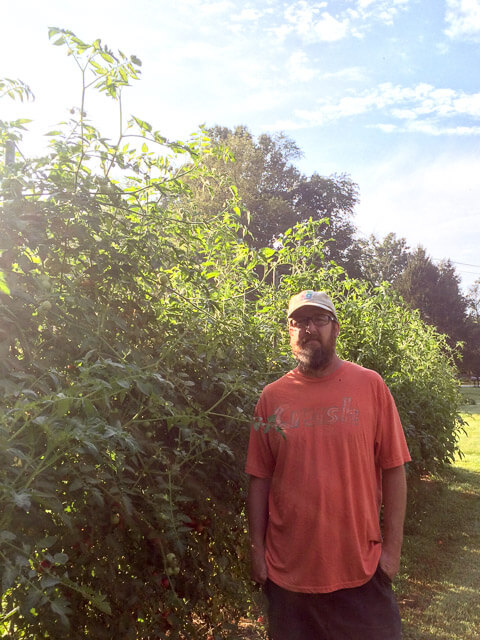
Have you been there?
Maybe it was your zucchini…or beans….or broccoli…. Some planting that grew like CRAZY. Everything ready to harvest at once. Abundance verging on overwhelm.
It’s the feeling when you have waaaay more of something than you can possibly eat—gratitude and celebration mixed with regret and guilt. You don’t want to let food go to waste!
We have a four-part plan for making the most of any summer harvest. Let me share it with you, and then I’ll give you specific examples (and recipes!) for how we’re using tomatoes this season at the end. Hopefully, our list will spark a few ideas for you when you’re knee-deep in the summer harvest.
1. Eat lots of vegetables.
Too obvious? 🙂

It actually took us a long time to make vegetables the largest portion on our plates. I’d grow all this beautiful food, and we’d end up eating whatever familiar/convenient food we had in the pantry or freezer. Over time, we’ve learned how to cook and enjoy more fresh veggies.
We did the Whole30 challenge earlier this year, and it helped push us firmly into the “veggies at every meal” camp. (Eating veggies at breakfast was weird for me at first. Now, it seems weird to eat a breakfast without them.) We get to truly enjoy the abundance, and we’re eating healthier, too.
We start with a serving of protein and fill the rest of our plate with veggies cooked in a healthy fat (or raw drizzled with one.) For example, we might have greens sautéed in grass-fed butter or a salad with a simple olive oil and vinegar dressing.
The boys don’t always gobble up their veggies, but when we offer less mac-n-cheese and hold the fruit until dessert, they’re wiling to taste more. We consider that a win.
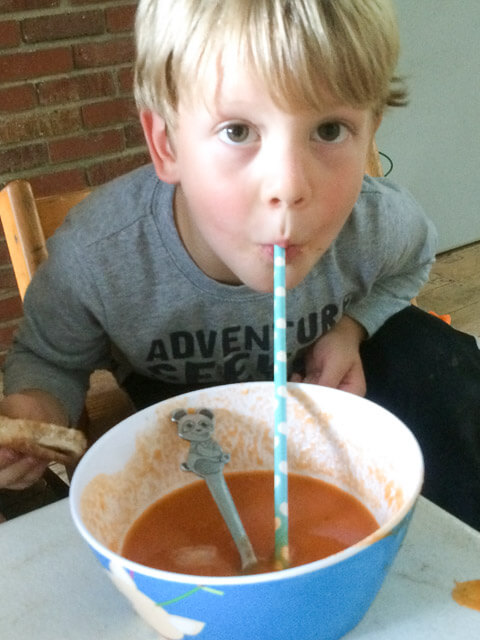
Tomato soup was a hit!
As busy parents, we especially appreciate a batch cooking practice we learned from Mel Joulwan’s book Well Fed. (Her book is full of great ideas and recipes. Highly recommended!)
Here’s the basic idea: Each week, you prep a bunch of veggies by roasting, steaming, sautéing them. Store them in the fridge and then each meal pull out what you need, heat it up, and season it to go with whatever else you’re making. I haven’t made this a habit yet, but when I do it, I love how easy it is to prep meals that are veggie-packed.
2. Preserve with simple methods and help from friends.
Next up in our plan for the summer harvest, put up the bounty to use all year-round. (Details on the tomato preservation methods we’ve tried below!) We’re still learning about food preservation, but so far, we’ve found two keys.
First, we look for the simplest ways to preserve.
We do some canning, but our chest freezer holds the bulk of our excess harvest. It’s simple to clean the veggies, cut them up, blanch them (if needed), and then freeze them for later.
- With foods like green chiles, berries, or peach slices that we use a little at a time, I flash freeze it on a tray first. Then, I put them into a freezer bag. It’s easy to get one chile or a cup of frozen fruit later.
- For liquids like tomato sauce, I’m careful to put bags onto a flat tray while they freeze. These lovely flat packages are so much easier to stack in the freezer than big globs!
- This flat freezer bag approach works nicely for greens, too. If you don’t need a whole package, you can break off a chunk of spinach for your smoothie.
- When a little goes a long way, ice cube trays are super handy. Think tomato paste or pesto. Freeze, then pop the cubes into a bag for easy access later.
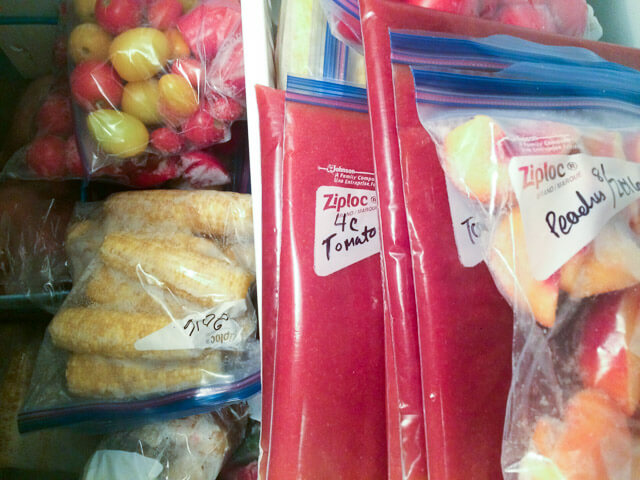
Of course, if it stores well at room temperature without much prep, we take that route first. Potatoes and apples keep well in our cool, dark basement. The basement is a little damp for garlic, onions, and winter squash. So after curing, they get stored in the pantry or a cabinet. We try to keep an eye out for spoilage and pull anything that starts to go bad before it affects the rest of the bunch.
Second, we ask for help from friends and family.
Many hands make light work, right?
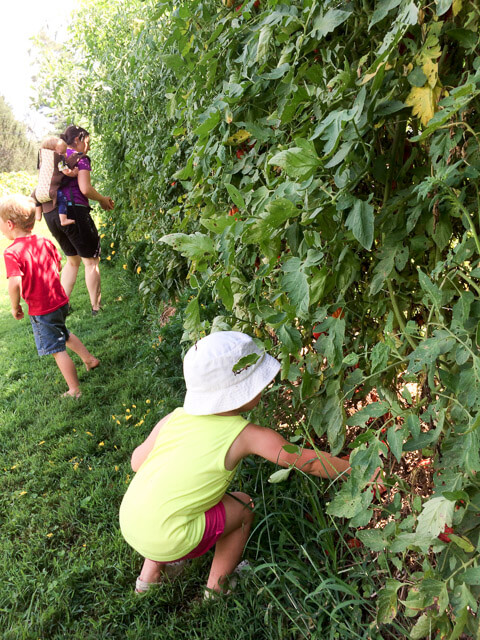
In some situations, it’s hard to ask for help, but I’ve found harvest time is not one of them. Everyone seems happy to pitch in with picking and cleaning the produce.
A wheelbarrow full of sweet corn + someone dear to help shuck and clean it = one of my favorite ways to spend an afternoon. It’s such fun to talk with friends while working, and I love being able to send them home with part of the harvest, too.
I was thrilled when a friend and her kids came to visit last week and volunteered to help with a farm projects.
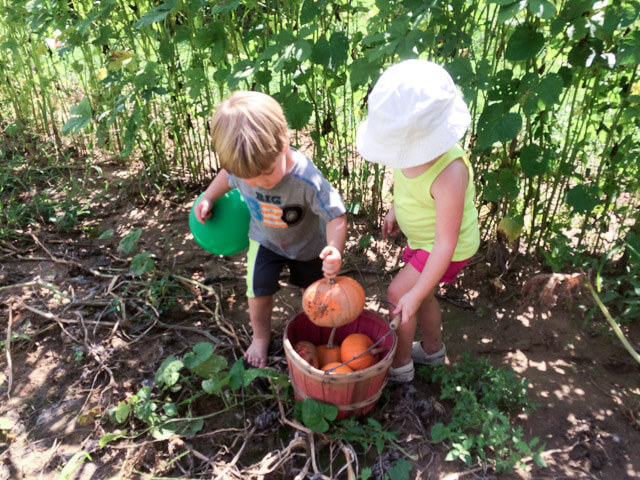
The kids worked together to find all the ripe pumpkins and winter squash and helped carry them to the curing screens. Then, we all picked tomatoes. The kids enjoyed a show while the moms cooked up a fantastic fresh tomato sauce (if I do say so myself!) to serve over spaghetti squash and noodles.
But the kids don’t always stick with it…
Our kids often start in earnest and then drift into their own activities of bug catching, flower picking, or tomato “juggling.” We make it easy for them to help with kid-sized buckets, clear instructions, and flexibility in the perfection of the final product. We love to have their help in the garden. At the same time, we’re also happy to see them immersed in play as long as they are safe nearby.
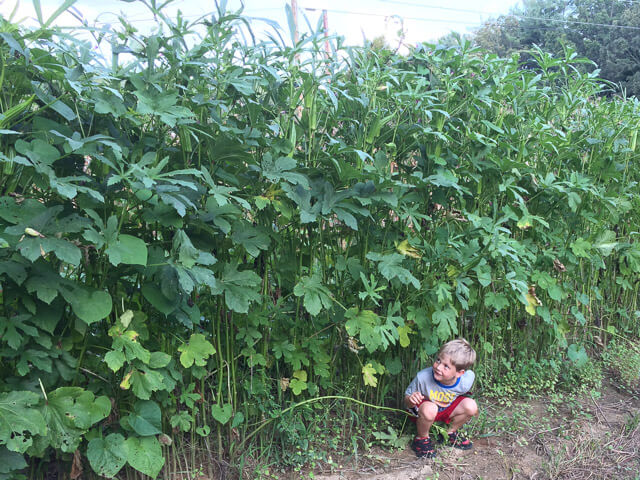
Hide and seek in the okra!
My parents have been amazing this season with helping care for the kids and taking the lead on some of our preserving projects. We couldn’t have done it without them! We all worked together to harvest and freeze corn and broccoli, pressure can green beans (Nana’s specialty!), and can tomatoes and salsa.
Would having a few extra hands help you put up some of your summer harvest for winter eating? Who could you ask for help in preserving your harvest?
3. Share the bounty.
One of the best parts of the summer harvest is getting to share it with others.
Be the talk of the next potluck with your garden-fresh dish. But don’t stop there! Here are 5 other ways you can share the bounty:
- Ask your local food bank how you can give fresh food. Plant a Row for the Hungry is a nationwide movement that can help you connect with others fighting hunger by growing food.
- Host a tasting party and give friends a chance to vote on their favorite variety or dish.
- Take a basket of food (and small bags to carry it home) to school, work, or church.
- Meet (or visit) your neighbors by delivering a bag of garden goodies.
- Organize a garden trade. Call together your gardening friends and acquaintances to trade your tomatoes for their green beans. You’ll get to exchange garden tips and tricks, build relationships, and everyone goes home with something new.
4. Recycle what’s left of your summer harvest (without guilt!).
In an ideal world, we’d all capture every bit of the garden goodness in colorful dinner plates, pantries, and freezers. But, let’s be real.
You will find monster zucchinis, miss some ears of corn, or have tomatoes go bad on your counter. Don’t fret.
In nature, nothing is ever wasted. And in your garden, you don’t have to “waste” food either. Turn your trash into treasure through the magic of the compost pile!
You can compost much of the waste from your garden, but be careful in two areas—disease and seeds.
If your compost pile isn’t hot enough for long enough, disease-causing pathogens and seeds can survive the process and return to your garden in the finished compost. (Even the commercial compost we bought a few years ago had a few tomatoes sprout from it.)
For diseased plants, bury their remains away from the garden or burn them carefully. For seedy material, you can do the same thing. But we have a secret weapon.
Chickens!
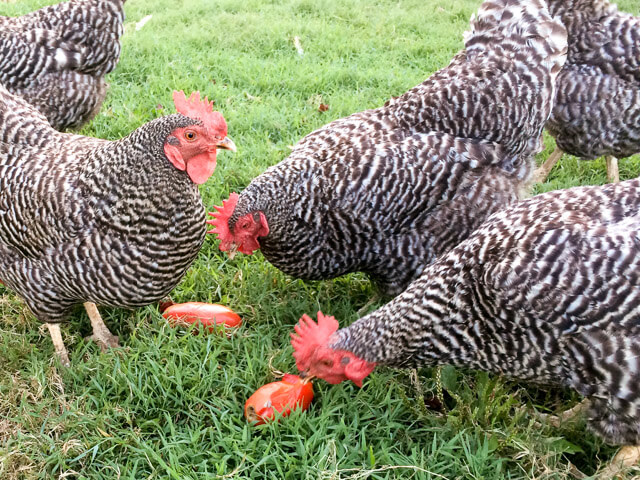
They’ll eat the rotting tomatoes and most of the waste from your summer harvest. If the seeds are eaten, they are unlikely to survive digestion.
“Chickens destroy 98 percent or more of the weed seeds in feed because of the grinding action of their gizzards.”
– Karen Renne, Michigan State University
If the chickens are in a future planting area, we leave their droppings to enrich the soil there. If not, we shovel up the manure for the compost pile.
New to composting? Check out our mini-course Quick Start to Composting. It’s free and takes less than an hour to get started.
Now, what are we doing with all these tomatoes?
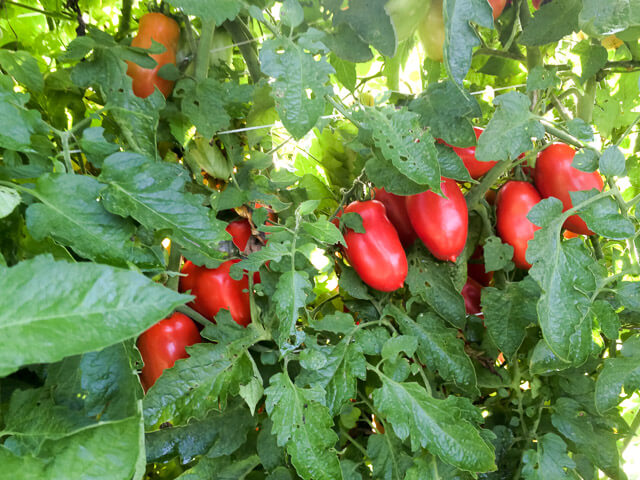
Here are the dishes we’re loving and the simple preservation techniques we’re using:
- Sliced tomatoes, sprinkled with salt, have been part of 6 of the last 7 meals.
- Tomato and Cucumber Salad – When we’re short on time, we skip the homemade dressing, and pour on Drew’s Roasted Garlic and Peppercorn.
- Best Homemade Tomato Soup with Garden-Fresh Tomatoes – We made a zesty soup based on this recipe that was fantastic. We’ll definitely be making more!
- Quick Fresh Tomato Sauce
- Roasted Cherry Tomatoes – I love the way roasting brings out the sweetness.
- Simply, toss cherry tomatoes in olive oil, salt, pepper, and garlic.
- Roast them at 350-400 degrees (depending on what else you’re cooking) until their skins pop open.
- Garden Veggie Soup – My grandma made an amazing vegetable soup that she sold by the quart each Saturday at the “Curb Market.” It was different every time, but it always included tomatoes. She used whatever vegetables were in season, so the soup might have included any combination of squash, green beans, pre-cooked dried beans, potatoes, okra, carrots, celery, greens, and corn. She didn’t write down the recipe, but here’s my version:
- Saute onions in olive oil. (Add carrots and celery now if you have them.)
- Add a few cups of chicken or beef stock. Bring to a boil.
- Cut all your veggies into 1/2″ pieces. (So that several will fit on your spoon at one time!)
- Drop in harder veggies first.
- Add your diced tomatoes and/or a simple tomato sauce. (I usually remove the skins and cores before I dice them.)
- Drop in the rest of your softer veggies.
- Simmer until your veggies are tender.
- Salt and pepper to taste.
- Enjoy!
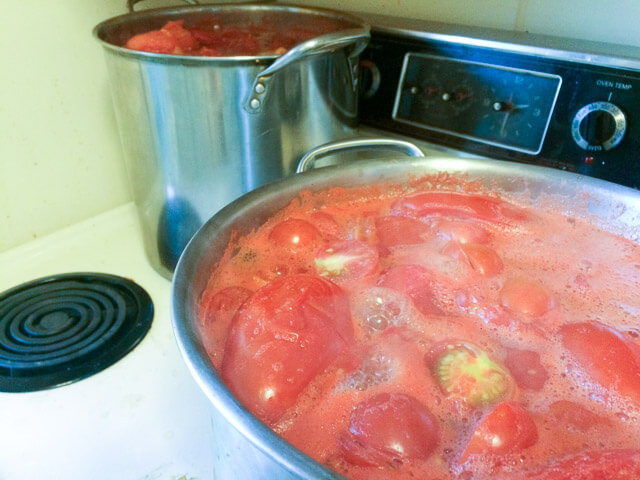
- Frozen tomatoes, whole – This is the simplest way I know to preserve tomatoes and many vegetables in the summer harvest. Simply wash them off, allow extra water to drip off, put into a bag and freeze. When they thaw, their skins will slide off easily and they are very soft. Great to use in casseroles, soups and sauces.
- Freezing, sauce – I cooked up a few big pots of tomatoes with very basic seasonings (salt, pepper, and garlic) so I can season it to match whatever dish I’m using it in later.
- Wash the tomatoes and add them to a pot with an inch of water. Smash them a bit to get more liquid.
- Bring to a boil, then turn down the heat and stir often. (I cooked mine on low and still scalded the bottom. Happily, I was able to scoop out most of the tomatoes without disturbing the burnt bits at the bottom too much.)
- When they are soft, run the tomatoes through a food mill to remove the skins and seeds. (If you don’t have a food mill, a sieve will work.) Then, put the sauce back on the stove and keep stirring as some of the water cooks out.
- Freeze in bags on a tray.
- Canning, whole and juice – Nana and I canned whole tomatoes (with skins removed) and the juice leftover from draining the salsa tomatoes. We used 1/2 teaspoon of citric acid per quart to make sure the acidity was at a safe level. (For canning, the state cooperative extension services are my go to resources. Here’s a great writeup about canning tomatoes from Clemson’s Cooperative Extension.)
- Canning, salsa – Since salsa is Colby’s favorite condiment, we wanted to can some this year. He was excited that we’d grown almost all of the ingredients. We had the onions, garlic, and of course, tomatoes. We only had a couple jalepenos and our cilantro had bolted, so we bought those ingredients from a local farmer. Here’s the recipe that we used.
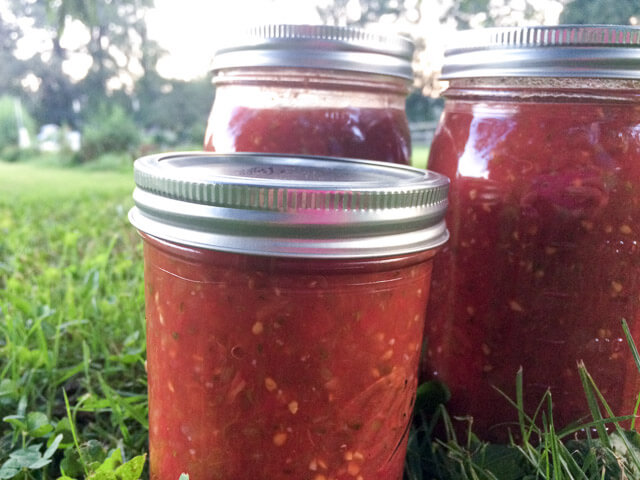
Are you drowning in a summer harvest? How do you like to eat and preserve the abundance?
We’d love to hear about your favorite recipes and tips for preserving. Share them in the comments below.
